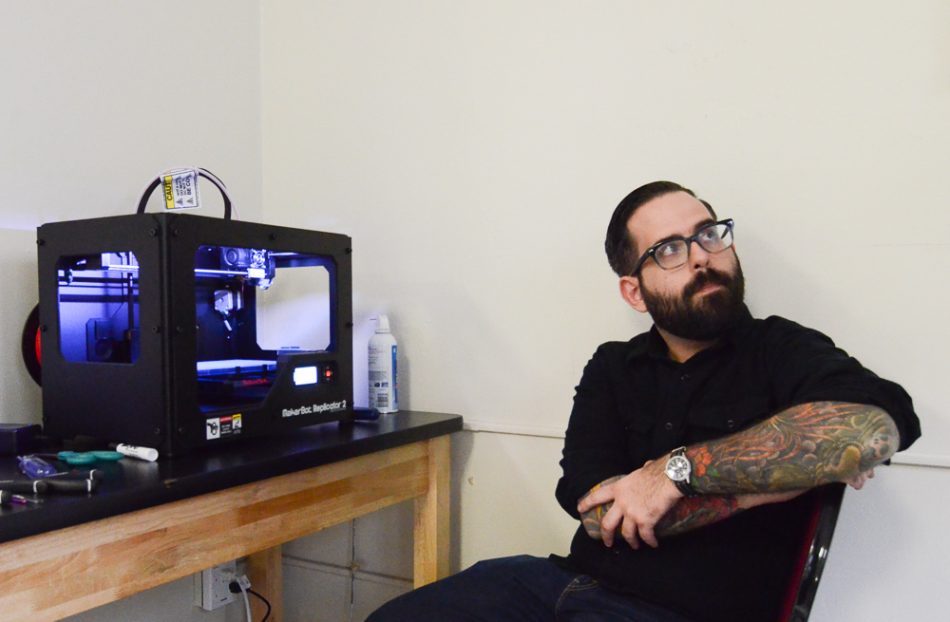
Klint Kanopka still remembers the time when technology’s purpose in school could be boiled down to defeating your classmates on the Oregon Trail.
“Even shop class used to carry a negative stigma,” Kanopka said, “and it was never really taken seriously.”
Those days are long gone, as students from a number of Philadelphia schools have access to a variety of makerspaces, which are dedicated areas that provide resources to students who are particularly interested in STEM-initiatives.
Earlier this year, the makerspace at the Academy at Palumbo was just a storage room. Kanopka, a physics teacher at the school, recognized an opportunity to turn it into a space for innovation and hands-on learning.
“It’s still slow,” Kanopka said. “It’s still growing and we’re still getting more stuff in here.”

Right now, he uses the space as an extension of his physics classroom, where he can teach CAD seminars on their Makerbot 3-D printer, and how to work with Arduinos, which are easy-to-use circuit boards designed to help create interactive objects and environments.
The space is also an area where creativity, innovation and technology intercede, allowing students to learn skills that may not be taught in traditional classrooms.
“If they have an idea for something they want to create, they can come in and we’ll discuss it,” Kanopka said. “They’re able to learn what it takes to actually implement their ideas.”
Technically Philly recently detailed the efforts of some students from the Academy to map crime in their area, which won them a $140,000 prize package from Samsung’s Solve for Tomorrow competition. The details of what’s involved in the package have not been disclosed.
Makerspaces for students are not just limited to being on location at schools, however – especially since funding remains a large obstacle. This is where organizations like NextFab are trying to make a difference.
NextFab is a high-tech workshop and prototyping center in South Philadelphia. Its 20,000 square-foot facility features a metal-shop outfitted with a water-jet, a CNC mill and a plasma cutter, as well as a woodshop, multiple 3-D printers and a laser cutter.

For anyone wishing to become a member of NextFab, training classes are provided since some of the machinery is quite dangerous. But the outreach manager, Jonathan Tekac, is trying to partner with local schools so that students can have access to the resources too.
“I think makerspaces for kids these days should be of the most primary importance,” Tekac said.
He is currently developing a six-week after school course with students from Chester A. Arthur and Edwin M. Stanton. Employees at NextFab will teach students from both schools how to use Adobe Illustrator so they can use it in a design challenge for their respective schools. When the six-week course is over, NextFab will laser-cut their designs and unveil them at a networking open house on May 31st.
Both schools are also pursuing their own makerspaces but are struggling with funding. The open house will double as a fundraising event, as Tekac expressed plans to donate $50 from each attendee to each school to assist them in obtaining resources for their own makerspaces.
“The idea here is that we want to be able to create an environment where people are passionate about technology, and they come together and interact with each other,” Tekac said. “If we can create those social interactions, the result will be innovation, which is the most powerful tool there is.”

Tekac is also working with Kanopka to give some the students from the Academy a tour of NextFab, with the possibility of working together in the future.
“I want my students to know that there’s a place outside of school where they can take their ideas and do something with them,” Kanopka said.
NextFab also collaborates with three other organizations – The Hacktory, Public Workshop and STEAM Initiative – to produce the Department of Making and Doing (DM+D), a makerspace based out of the University City Sciences Center.
Michael Darflur, the Program Manager at the DM+D, said, “We provide an opportunity for kids to have a different learning experience that’s more hands-on, and based more in experiential, project-based learning as opposed to classroom learning.”
The Public Workshop program works with the Science Leadership Academy, a high school that is a partnership between the School District of Philadelphia and the Franklin Institute. The program uses the space at the DM+D, and every week it runs a workshop for students from the SLA. Some workshops focus on teaching the students particular digital skills, while others help the students design and build their own projects. Recently, they worked on prototyping furniture for the SLA.
“We’re kind of a hybrid design, technology and co-working space,” said Alex Gilliam, the director of Public Workshop, “which is really cool because instead of talking to kids about STEM-professions in an abstract way, they’re able to work in the same space with designers and see the types of professions that these opportunities will open up for them.”
These spaces reinforce the notion that science and creativity are not mutually exclusive. And when makers and doers are able to harmonize these two fields, it results in the creation of new technologies that are speeding us into the 21st Century.
Mary Beth Hertz, a technology integration specialist and teacher at the SLA, knows how important it is for students to learn-by-doing in a creative environment.
“Once upon a time, schools had shop class and ‘home-ec.,’” she said. “These were classes where kids built things and learned how to make with their hands. I see the rise of makerspaces as a movement to put these hands-on learning opportunities back into schools.”
– Text by David Ziegler; photos by Chris Montgomery



Be the first to comment